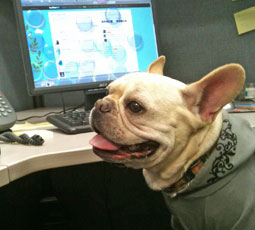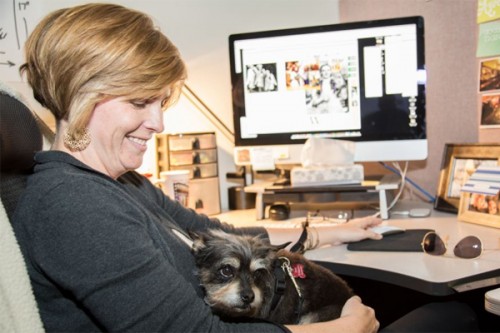Take Your Dog To Work Day: Tips, Tricks and Essential Advice
This year marks the 15th Pet Sitters International’s Take Your Dog To Work Day. The day was created to celebrate canine companionship and boost adoptions. While we all know it’s fun to be able to take your dog to work instead of leaving them behind one day of the year (unless you are lucky enough to work for a company that welcomes pets year round) the day can also cause accidents, especially if you have non-dog savvy workers or a fearful pup.
15 Tips for a Successful Take Your Dog to Work Day

Bathe and groom your dog before her office debut so she is clean and odor-free, and free of any parasites such as fleas or ticks.
Only allow dogs to visit the office who are up-to-date on vaccines, and never bring your dog if he appears sick.
If your dog is aggressive or overly shy, keep him at home. Meeting new dogs and people in an unfamiliar environment can be too stressful for some dogs.
Bring with you everything your dog might need, including food, treats, bowls, toys, and a leash. And don’t forget paper towels, clean-up bags, and pet-safe disinfectant.
To keep your dog comfortable, consider bringing a crate, especially if you are routinely in and out of your office workspace.
Designate an appropriate area where dogs can relieve themselves and stress that people need to pick up after their dogs.
Avoid forcing co-workers to interact with your dog. Those who are interested will seek out you and your dog.
Monitor the amount of treats your pet eats, and educate co-workers ahead of time about what is and isn’t safe for dogs. Bring extra food or treats that your dog is used to that people can safely feed your dog.
Have an exit strategy. It’s OK to take him home at anytime if he is uncomfortable or boisterous and causing a distraction.
Remember that the point of TYDTWD – aside from having fun – is to educate people about pet adoption and helping pets in need.
If your office is closed on Friday or employees are interested in bringing other pets, consider celebrating on another day during Take Your Dog to Work Week, June 16-20, 2014. Or any other time of the year!
Ask your local shelter or rescue group to join your TYDTWD event. They can bring adoptable pets or information about local adoption opportunities and you can hold a fundraiser to benefit the guest shelter.
Take lots of pictures, and share them on your company’s website or social media pages. You could also have a photo contest or award prizes for cutest dog or best owner-dog look-a-likes.

7 Rules Everyone in the Office Should Follow for Take Your Dog to Work Day
Have a great Take Your Dog to Work Day by following these rules! If you have any questions, always ask your co-worker first before say hi to their dog.
Never approach another co-worker’s dog with your dog, it may not be dog-friendly
Always ask your co-worker before you greet the dog
Always approach a dog from the side, do not stare directly at the dog’s face, and do not reach over the dog’s head
Do not approach a dog that a co-worker has left alone in their office
Do not feed a dog without permission (she may have allergies)
Avoid coming up behind a dog, it can startle him
Avoid bending over a dog. Instead, kneel by their side
If you know your dog is shy of people, tie a yellow ribbon on his leash and collar for the day, so the rest of the office will know.
If you see a yellow ribbon on a dog, the best thing to do is ignore him. Even if he comes up and sniffs you. Just because he is checking you out to see if you are a threat, does not mean they want you pet him.

Look for these signs and stop approaching the dog if you see any of them, even if the owner is telling you the dog is friendly. All of these are signs the dog is uncomfortable and may bite if pushed.
Whites of the eyes
Cowered, low body posture
Tail low-set and/or tucked (for breed)
Ears low or back
Piloerection (hair along back and neck raised)
High tail set (for breed) with a slow or very rapid wag
Freezing
Backing away
Hiding behind owner or furniture
Baring of teeth
Growling, barking
Lunging
Use your best judgment and err on the side of caution. If you are unsure, it’s best to just not pet the dog.





